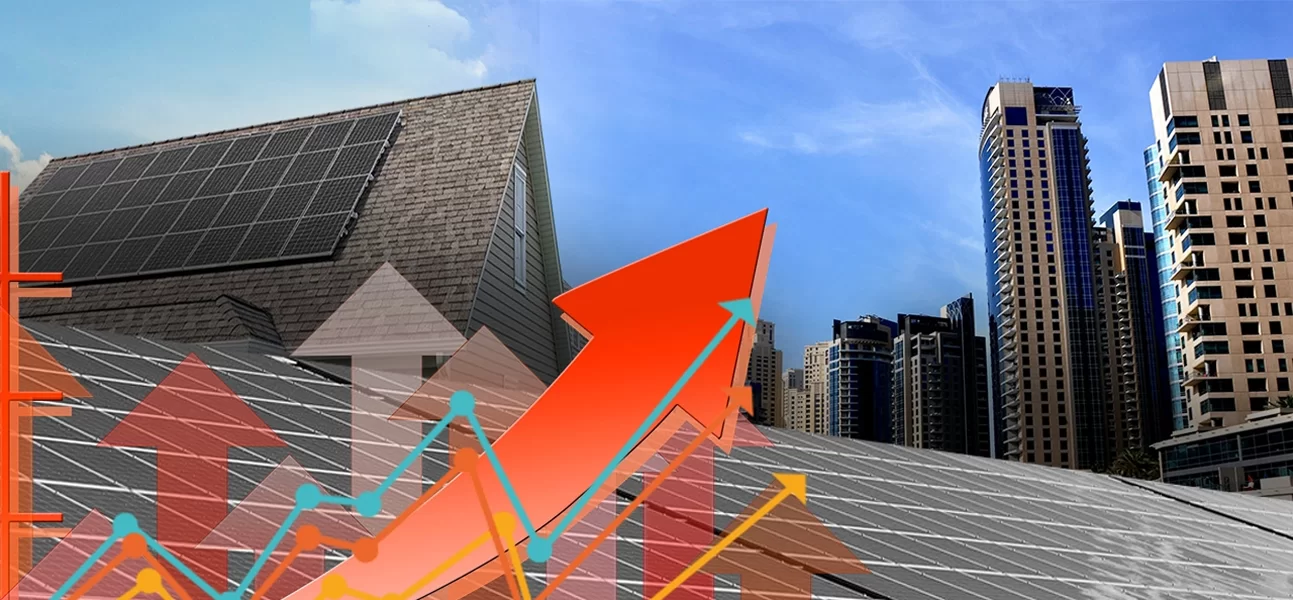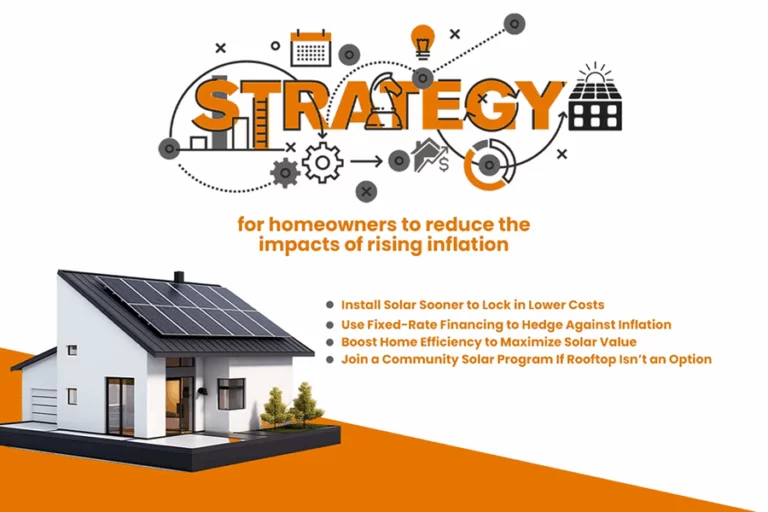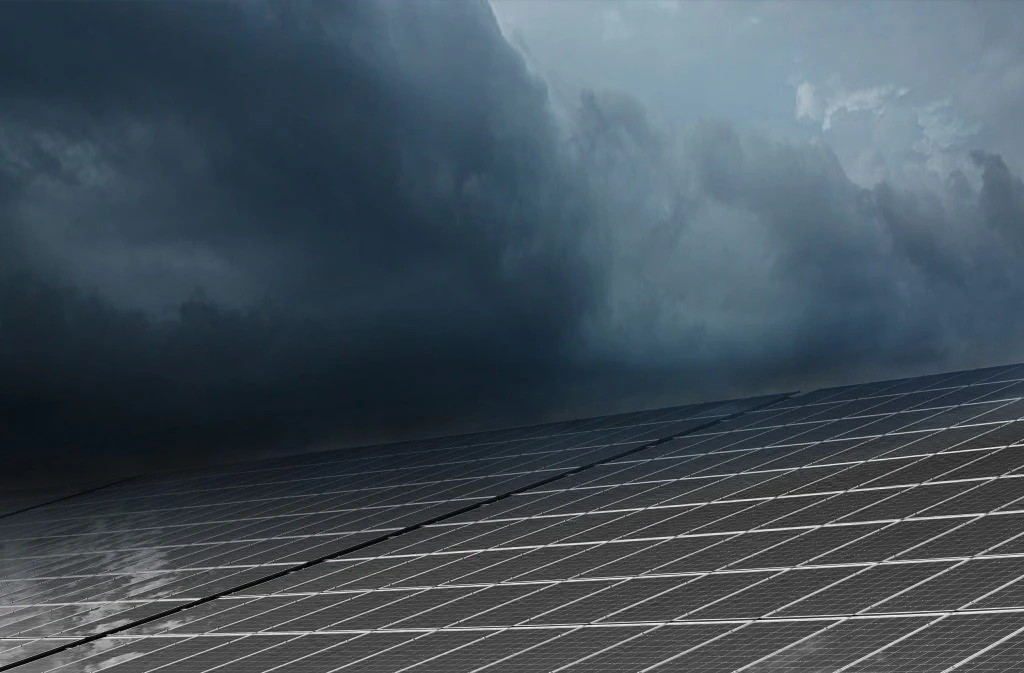- Published On:
Rising Inflation in the Solar Energy Market: Key Challenges and Opportunities for Low Solar Costs
With booming inflation and economic insecurity in the United States, costs on consumer commodities have increased by as much as 3% between 2024 and 2025. With increasing inflation, even solar energy costs are a major concern for homeowners and also for the solar energy industry. Increasing rates on materials, labor, and interest are striking the solar installations more than ever before.
Homeowners are encountering many issues like new solar tariffs, high electric bills, and increasing cost per watt of solar panels. Residential solar installations declined by 32% because of high prices and shipping delays. Despite all these obstacles, homeowners are still able to reduce the inflationary high upfront solar costs with the available solar tax credits, local solar rebates, and home solar loans.

Inflation Trends in the Solar Energy Market
The inflation severely impacted the U.S. solar market like stretching from tariffs imposed on solar panels being imported into the country and exaggerated material costs to higher interest rates. There has been a subsequent rise in the prices of solar panels in the U.S. due to the 25% to 50% tariffs imposed on Chinese solar cells. Tariffs on steel and aluminum have also gone up, raising the cost of solar infrastructure and impacting project budgets. Federal Reserve interest rate hikes have also driven up the cost of borrowing, impacting the financing of solar projects.

Despite the setbacks, the U.S. solar market put in about 50 GW of capacity in 2024, a 21% rise from 2023, and domestic module manufacturing capacity grew 190% year over year. The residential solar market, meanwhile, had its worst year of installations since 2021, due in part to higher prices and policy changes. Actions to promote domestic manufacturing and shore up supply chains are being taken to help counteract the impacts of inflation on the solar industry.
What are the major impacts of rising inflation on the solar industry?
This year will be crucial for the renewable energy sector as homeowners and industry players deal with growing electricity costs, possible modifications to federal incentives, and changing supply chain difficulties. Some of the major impacts include:

Rising Electricity Rates:
In the United States, electric costs are escalating at a record high, beyond previous 20-year energy cost inflation rates. Electricity costs now are increasing by approximately 5% annually, according to the Lawrence Berkeley National Laboratory. The residential electric rates have increased due to new rate hikes by utilities like Xcel Energy. The trend highlights why homes need to be energy self-sufficient. Going solar is offering consumers a choice of saving on their energy bills and protecting themselves against future price hikes.
Potential Adjustments to Federal Tax Credit:
The 30% federal Investment Tax Credit (ITC) for home solar systems is one of the key financial incentives to help lower the cost of solar installation. However, with the political changes, radical alterations are expected in the Inflation Reduction Act. Our suggestion to homeowners is to take advantage of the best solar incentives available. Booking your solar installation earlier can help you take advantage of the best financial incentives.
New Solar Tariffs on Imports:
The new solar tariff named the “Liberation Day Tariff” imposed by President Trump can raise new challenges for the solar industry and homeowners about the affordability of solar, supply chain, and installation process. As per the new tariff plan, a 10% duty will be imposed on all imported products. But the countries having a trade imbalance with America will face higher rates, like a 125% tariff on Chinese imports, whereas Vietnam, Malaysia, Thailand, and Cambodia can expect 36%-49% higher rates.
Supply Chain Challenges:
More taxes on solar panels and international trade policies are leading to price uncertainty in the solar sector. With additional tariffs on the equipment from Southeast Asia, new anti-dumping charges lead to decline in the import volume of crystalline solar panels. The supply and price of solar panels are thus uncertain due to the disruption. In order to prevent possible delays and increased expenses, interested homeowners must look for trustworthy solar installers with stable access to supply chains.
What are the strategies for homeowners to reduce the impacts of rising inflation on solar installation costs?
The following strategies may help homeowners to install their home solar systems with lower upfront costs:

Plan your installation Sooner
Although inflation increases the price of solar equipment and installation each year based on materials like silicon, copper, and aluminum. By installing solar panels system sooner rather than later, homeowners can take advantage of current prices before more inflation or supply shortages push prices even higher. Also, acting sooner allows you to qualify for federal incentives like the 30% Investment Tax Credit (ITC) and local solar rebates, which won’t last forever.
Solar Financing
Financing a solar system can even counteract inflation. As inflation reduces the real money value over time, fixed-rate solar loans or Power Purchase Agreements (PPAs) are a strategic advantage. With regular monthly payments, homeowners pay using future dollars that are less valuable, leading to a reduction in the actual cost of solar. This protects against inflation as well as future rate hikes in utilities. Although inflation might influence financing and return on investment (ROI) of solar installations. However, Solar SME offers solar financing options like $0 down or low-interest rates, so homeowners can go solar without spending a high upfront investment. Also solar loans are available with low interest rates for making solar affordable for the communities.Lorem ipsum dolor sit amet, consectetur adipiscing elit. Ut elit tellus, luctus nec ullamcorper mattis, pulvinar dapibus leo.
Energy Efficiency Improvements
Reducing your overall energy consumption makes your solar investment more valuable. By installing insulation, switching to LED lights, or installing energy-efficient appliances, you can lower your home’s energy load. This means a smaller, cheaper solar system will cover your requirements. It also lowers the payback period and enhances the inflation-hedging benefits of solar.
Community Solar Programs
For homeowners who cannot have panels due to shade, roof condition, or rental agreements, a community solar program is a good alternative. The shared solar farms allow owners to subscribe and receive credits on their electric bill, usually at a rate lower than the regular utility rate. As the utility rate increases due to inflation and fuel prices, community solar offers a fixed, cost-effective means of countering the increases.
While rising inflation and shifting trade policy is imposing new cost pressures into the solar industry and domestic manufacturing growth, supportive state solar incentives enable homeowners to still lock in long-term energy savings though. By timely planning your installation, you can mitigate booming inflation and new solar tariffs impacts on your solar cost. Contact a local solar installer like Solar SME to explore best solar options and available solar rebates in your area. Also, you can estimate your solar savings with our smart solar calculator.
Related Articles:
The trend of solar installation is rapidly booming in the U.S. However, a common question of homeowners is “Do Solar Panels Work in Cold Weather?”
There are many ways to save with solar, including a 30% extended tax credit. The environmental benefits are the second most popular reason. Most of the power produced in the United States comes from the burning of fossil fuels such as coal and natural gas. In contrast, solar panels generate clean, renewable, and emission-free electricity. Explore the benefits of clean solar power and top reasons to invest!
Hurricanes are powerful natural disasters that can wreak havoc on buildings and destroy infrastructures causing economic and personal losses.



